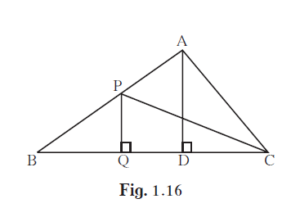In adjoining figure, PQ ⊥ BC, AD⊥ BC then find following ratios. (i) `("A"(∆"PQB"))/("A"(∆"PBC"))` (ii)`("A"(∆"PBC"))/("A"(∆"ABC"))` (iii) `("A"(∆"ABC"))/("A"(∆"ADC"))` (iv) `("A"(∆"ADC"))/("A"(∆"PQC"))`
Practice Set 1.1 | Q 5 | Page 6
In adjoining figure, PQ ⊥ BC, AD⊥ BC then find following ratios.
(i) `(“A”(∆”PQB”))/(“A”(∆”PBC”))`
(ii)`(“A”(∆”PBC”))/(“A”(∆”ABC”))`
(iii) `(“A”(∆”ABC”))/(“A”(∆”ADC”))`
(iv) `(“A”(∆”ADC”))/(“A”(∆”PQC”))`

(i) In ∆PQB and ∆PBC,
ΔPQB and ΔPBC have same height PQ. ...(Given)
ΔPQB and ΔPBC have same height PQ. ...(Given)
Areas of triangles with equal heights are proportional to their corresponding bases.
∴ `("A"(∆"PQB"))/("A"(∆"PBC")) = "BQ"/"BC"`
(ii) In ∆PBC and ∆ABC,
∆PBC and ∆ABC have same base BC. ...(Given)
Areas of triangles equal bases are proportional to their corresponding heights.
∴ `("A"(∆"PBC"))/("A"(∆"ABC")) = "PQ"/"AD"`
(ii) In ∆ABC and ∆ADC,
∆ABC and ∆ADC have same height AD. ...(Given)
Areas of triangles with equal heights are proportional to their corresponding bases.
∴ `("A"(∆"ABC"))/("A"(∆"ADC")) = "BC"/"DC"`
(iii) In ∆ADC and ∆PQC,
Ratio of areas of two triangles is equal to the ratio of the products of their bases and corresponding heights.
∴ `("A"(∆"ADC"))/("A"(∆"PQC")) = "DC × AD"/"QC × PQ"`
Explanation:- The statement is discussing various triangles and their areas, heights, and bases.
Firstly, it is given that in triangles ΔPQB and ΔPBC, they have the same height PQ. Since the areas of triangles with equal heights are proportional to their corresponding bases, the ratio of the areas of these triangles is BQ/BC.
Secondly, in triangles ΔPBC and ΔABC, they have the same base BC. Since the areas of triangles with equal bases are proportional to their corresponding heights, the ratio of the areas of these triangles is PQ/AD.
Thirdly, in triangles ΔABC and ΔADC, they have the same height AD. Since the areas of triangles with equal heights are proportional to their corresponding bases, the ratio of the areas of these triangles is BC/DC.
Lastly, in triangles ΔADC and ΔPQC, the ratio of their areas is equal to the ratio of the products of their bases and corresponding heights. Thus, the ratio of the areas of these triangles is (DC x AD) / (QC x PQ).
Chapter 1. Similarity- Practice Set 1.1 – Page 5
Click Here for All Textbook Soutions of Chapter 1: Similarity
